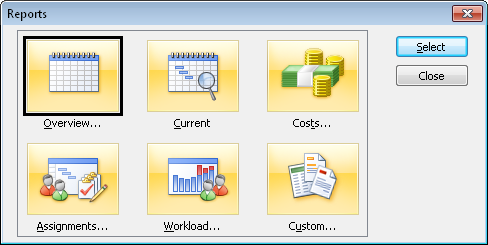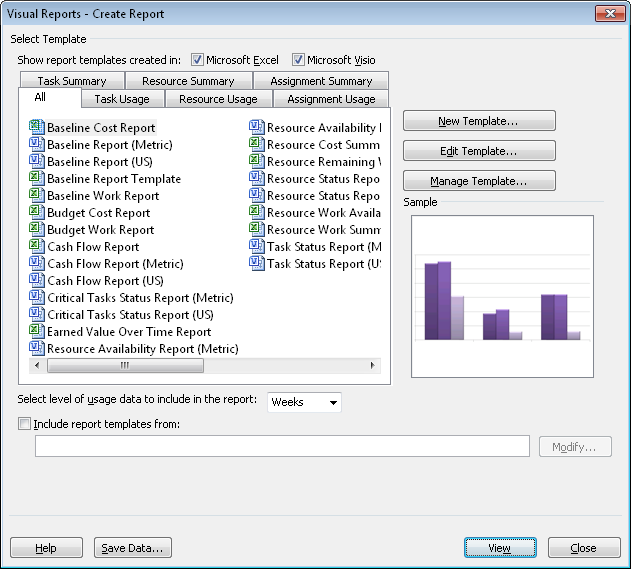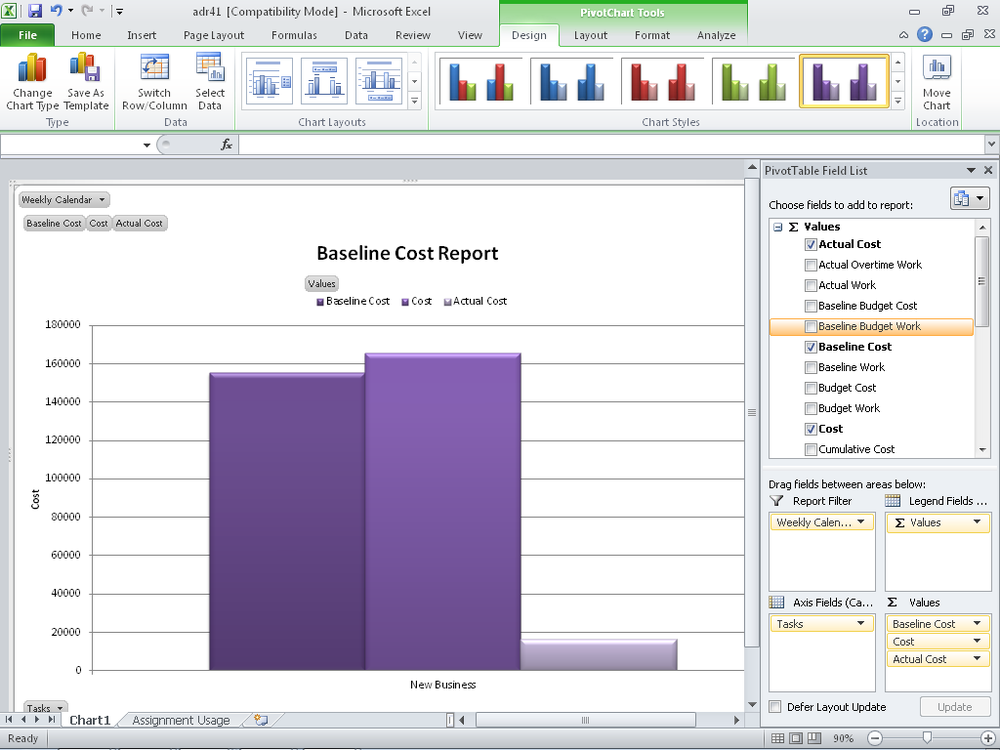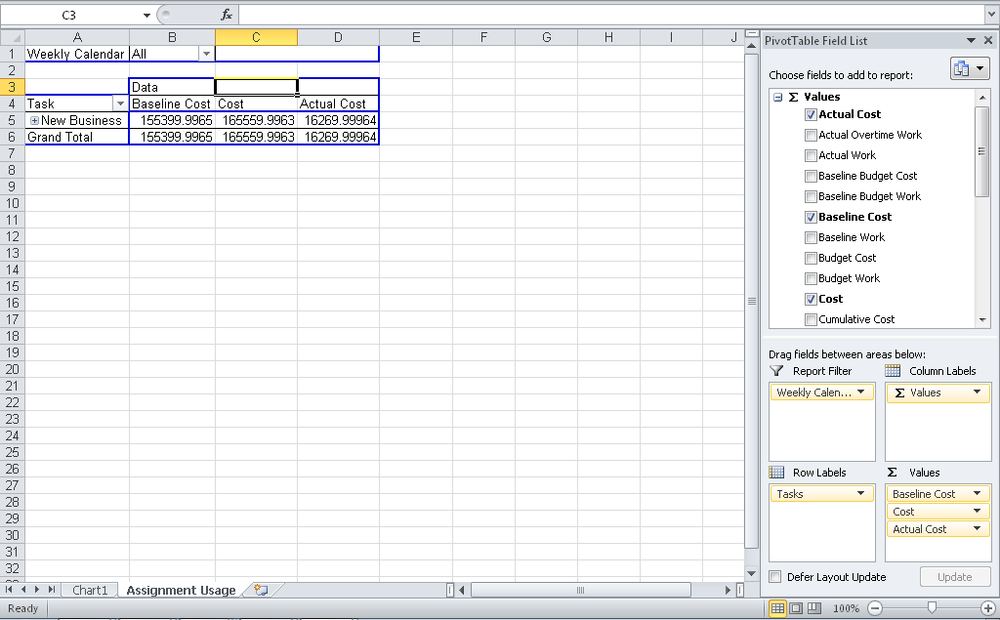In addition to the ability to print views, Project 2010 comes with more than 40 built-in reports that you can simply select, preview, and print. These reports compile the most commonly used sets of information needed to manage a project, coordinate resources, control costs, analyze potential problems, and communicate progress.
When you select and generate a report, information is drawn from selected fields throughout your project. That information is laid out in the predetermined report design or template, in either discrete or summarized form, depending on the specific report. You can generate an up-to-date report minutes before the start of a meeting, and the report instantly reflects the very latest changes you made or that team members have submitted.
You can generate two categories of reports: text-based reports and visual reports. The text-based reports compile information into a tabular format within Project 2010. Visual reports automatically compile and export project information to either Excel or Visio, where it is presented in a graphic such as a column chart or flow diagram.
To see the list of available text-based reports, click Project, Reports, Reports. The Reports dialog box appears, showing six report categories. (See Figure 13-3.)
Figure 13-3. There are five categories for 22 built-in text-based reports, plus a Custom category for designing your own report.
The text report categories are:
You might find that reports in a certain category are best suited to one type of audience, whereas reports in another category are better for another type of audience. For example, cost reports might be most appropriate for meetings with the finance department, but you might prefer to distribute assignment reports to team leads.
To generate these reports, Project 2010 gathers information from a particular time period, from certain tables, and with a particular filter applied as appropriate for the requirements of the specific report. Information is formatted with bands, highlights, fonts, and other professional layout considerations.
To select and print a text report, follow these steps:
On the Project tab, in the Reports group, click Reports.
In the Reports dialog box, double-click the category you want.
As shown in Figure 13-4, a dialog box appears, listing the available reports in the selected category.
Double-click the report you want.
If a dialog box prompts you for more information, such as a date range, enter the information, and then click OK.
The report appears in the Print Backstage view, providing print options and a preview of the report as it will be printed, as shown in Figure 13-5.
Click an area of the report to zoom in on that area. Click a second time to zoom back out again.
You can also zoom by using the Actual Size, Full Page, and Multiple Pages buttons in the lower-right corner of the preview pane.
In the lower-right area of the middle pane of the Print Backstage view, click Page Setup to change the page orientation, scaling, margins, header, or footer.
After clicking OK, your changes are reflected in the preview pane for the report.
Use the arrow buttons in the lower-right corner of the preview pane to page through the view.
In the middle pane, specify printing options such as the page range and number of copies.
When you’re ready, in the upper-left corner of the middle pane, click Print.
Just as text reports present project information in a tabular format, visual reports present project information graphically. When you generate a visual report, specific project data is compiled and sent to Excel or Visio. A PivotTable or PivotDiagram structure specifies how the data is to be displayed in the chart or diagram.
For an Excel visual report, a PivotTable is generated, from which a chart, such as a column or pie chart, is drawn.
A Visio visual report generates a PivotDiagram, a collection of boxes or other shapes arranged in a tree structure.
In either case, you can change the arrangement of the source data to display the information from different perspectives as needed.
To see the list of built-in visual reports, on the Project tab, in the Reports group, click Visual Reports. The Visual Reports - Create Report dialog box appears, as shown in Figure 13-6.
The visual report categories are:
Task Summary
Resource Summary
Assignment Summary
Task Usage
Resource Usage
Assignment Usage
The summary reports are more high-level, while the usage reports have specific detail.
To generate a visual report, follow these steps:
On the Project tab, in the Reports group, click Visual Reports.
In the Visual Reports - Create Report dialog box, click the tab for the report category you want.
You might find it easier to simply view the All tab and see the list of all 22 visual reports in one place.
If you only want to see the list of Excel visual reports, clear the Microsoft Visio check box at the top of the dialog box. If you only want to see the list of Visio reports, clear the Microsoft Excel check box.
Note that you must have Microsoft Excel or Microsoft Visio installed on your computer to generate the Excel or Visio visual reports. If Visio is not installed, the dialog box only shows the Excel report templates.
Click the report you want. Icons next to each report name indicate whether it’s an Excel or Visio report template.
A thumbnail representation of the report appears in the Sample box.
In the box labeled Select Level Of Usage Data To Include In The Report, select the period of time you want to use. The default is Weeks.
Click View.
Project 2010 gathers the information required by the selected report template, builds the OLAP (online analytical processing) cube (the set of fields that will be used), opens the template in the target application—either Excel or Visio—and finally displays the visual report in that application, as shown in Figure 13-7.
In Excel, if you want to view or change the PivotTable on which the report is based, click the second worksheet tab at the bottom of the Excel window. It’s named something like Assignment Usage or Task Summary, as shown in Figure 13-8.
To print a report in Excel 2010 or Visio 2010, on the File tab, click Print. In the Print Backstage view, make any changes to how the report should look when printed, such as headers or page orientation, specify any print options such as page range and number of copies, and then click the Print button at the top of the center pane.
To save a report in Excel 2010 or Visio 2010, on the Quick Access Toolbar, click Save. Specify where you want to save the report, give it a name, and then click Save.






